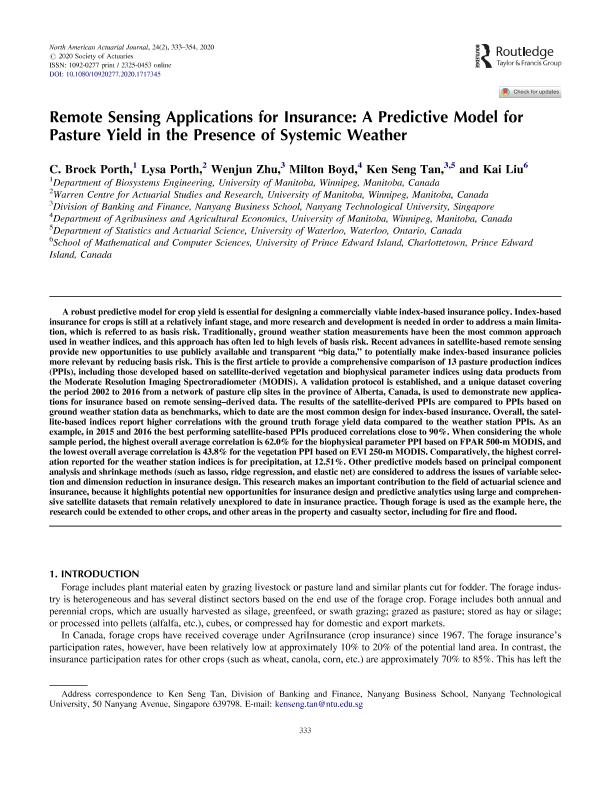Remote sensing applications for insurance: a predictive model for pasture yield in the presence of systemic weather

Contenido multimedia no disponible por derechos de autor o por acceso restringido. Contacte con la institución para más información.
| Tag | 1 | 2 | Value |
|---|---|---|---|
| LDR | 00000cab a2200000 4500 | ||
| 001 | MAP20200018155 | ||
| 003 | MAP | ||
| 005 | 20220911211150.0 | ||
| 008 | 200528e20200601usa|||p |0|||b|eng d | ||
| 040 | $aMAP$bspa$dMAP | ||
| 084 | $a6 | ||
| 245 | 1 | 0 | $aRemote sensing applications for insurance: a predictive model for pasture yield in the presence of systemic weather$cC. Brock Porth...[Et al.] |
| 520 | $aA robust predictive model for crop yield is essential for designing a commercially viable index-based insurance policy. Index-based insurance for crops is still at a relatively infant stage, and more research and development is needed in order to address a main limitation, which is referred to as basis risk. Traditionally, ground weather station measurements have been the most common approach used in weather indices, and this approach has often led to high levels of basis risk. Recent advances in satellite-based remote sensing provide new opportunities to use publicly available and transparent big data, to potentially make index-based insurance policies more relevant by reducing basis risk. This is the first article to provide a comprehensive comparison of 13 pasture production indices (PPIs), including those developed based on satellite-derived vegetation and biophysical parameter indices using data products from the Moderate Resolution Imaging Spectroradiometer (MODIS). A validation protocol is established, and a unique dataset covering the period 2002 to 2016 from a network of pasture clip sites in the province of Alberta, Canada, is used to demonstrate new applications for insurance based on remote sensingderived data. The results of the satellite-derived PPIs are compared to PPIs based on ground weather station data as benchmarks, which to date are the most common design for index-based insurance. Overall, the satellite- based indices report higher correlations with the ground truth forage yield data compared to the weather station PPIs. As an example, in 2015 and 2016 the best performing satellite-based PPIs produced correlations close to 90%. When considering the whole sample period, the highest overall average correlation is 62.0% for the biophysical parameter PPI based on FPAR 500-m MODIS, and the lowest overall average correlation is 43.8% for the vegetation PPI based on EVI 250-m MODIS. Comparatively, the highest correlation reported for the weather station indices is for precipitation, at 12.51%. Other predictive models based on principal component analysis and shrinkage methods (such as lasso, ridge regression, and elastic net) are considered to address the issues of variable selection and dimension reduction in insurance design. This research makes an important contribution to the field of actuarial science and insurance, because it highlights potential new opportunities for insurance design and predictive analytics using large and comprehensive satellite datasets that remain relatively unexplored to date in insurance practice. Though forage is used as the example here, the research could be extended to other crops, and other areas in the property and casualty sector, including for fire and flood. | ||
| 650 | 4 | $0MAPA20080592059$aModelos predictivos | |
| 650 | 4 | $0MAPA20080567484$aTeledetección | |
| 650 | 4 | $0MAPA20080552565$aSatélites | |
| 650 | 4 | $0MAPA20080617240$aInformacion meteorológica | |
| 650 | 4 | $0MAPA20140022717$aBig data | |
| 650 | 4 | $0MAPA20080598358$aProductos de seguros | |
| 650 | 4 | $0MAPA20080611804$aParámetros atmosféricos | |
| 650 | 4 | $0MAPA20080627904$aCiencias Actuariales y Financieras | |
| 650 | 4 | $0MAPA20130017037$aAnálisis predictivos | |
| 700 | 1 | $0MAPA20200012733$aBrock Porth, C. | |
| 773 | 0 | $wMAP20077000239$tNorth American actuarial journal$dSchaumburg : Society of Actuaries, 1997-$x1092-0277$g01/06/2020 Tomo 24 Número 2 - 2020 , p. 333-354 |

